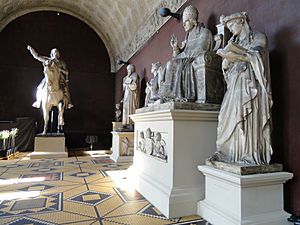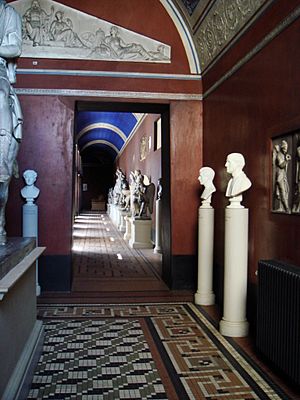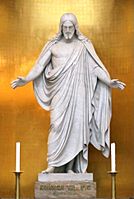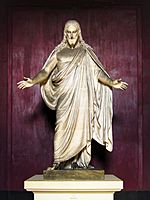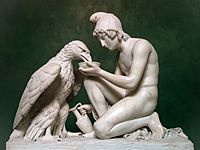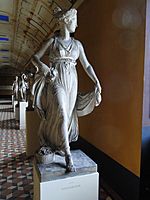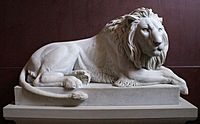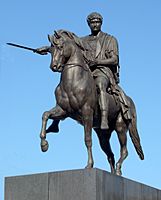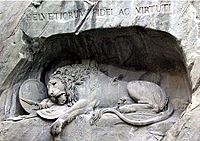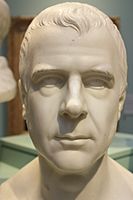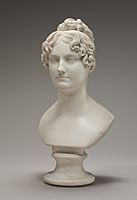Bertel Thorvaldsen facts for kids
Quick facts for kids
Bertel Thorvaldsen
|
|
|---|---|

Portrait by Carl Joseph Begas, ca. 1820
|
|
| Born |
Albert Bertel Thorvaldsen
19 November 1770 Copenhagen, Denmark
|
| Died | 24 March 1844 (aged 73) Copenhagen, Denmark
|
| Nationality | Danish |
| Known for | Sculpting |
Bertel Thorvaldsen (born 19 November 1770 – died 24 March 1844) was a very famous Danish sculptor. He was known around the world for his art. Thorvaldsen spent most of his life, from 1797 to 1838, living and working in Italy.
He was born in Copenhagen, Denmark, into a family that worked with their hands. At just eleven years old, he was accepted into the Royal Danish Academy of Art. He worked part-time with his father, who carved wood. Thorvaldsen won many awards and medals at the academy. He even received a special grant to travel to Rome and continue his art studies.
In Rome, Thorvaldsen became a well-known sculptor. He had a large workshop in the city. He worked in a style called neo-classicist, which looked back to ancient Greek and Roman art. People from all over Europe bought his sculptures.
When he returned to Denmark in 1838, Thorvaldsen was welcomed as a national hero. The Thorvaldsen Museum was built to display his artworks. It stands next to Christiansborg Palace in Copenhagen. Thorvaldsen is buried right in the museum's courtyard. Many people at the time saw him as the next great sculptor after Antonio Canova. His famous public statues include those of Nicolaus Copernicus and Józef Poniatowski in Warsaw. He also created the tomb for Pope Pius VII in St. Peter's Basilica. This was special because he was not Catholic.
Contents
Bertel Thorvaldsen's Early Life and Training
Bertel Thorvaldsen was born in Copenhagen in 1770. His father, Gottskálk Þorvaldsson, was from Iceland and worked as a wood-carver. He made beautiful decorations for ships. His father's work greatly influenced young Bertel and helped him choose to become a sculptor. Thorvaldsen's mother was Karen Dagnes.
His childhood in Copenhagen was simple. We don't know much about his early schooling. He might have learned mostly at home.
In 1781, when he was eleven, Thorvaldsen was accepted into the Royal Danish Academy of Art in Copenhagen. He first studied drawing, then moved to the modeling school in 1786. At night, he helped his father with wood carving. His teachers, like Nicolai Abildgaard, likely inspired his later neo-classicist art style.
Thorvaldsen was highly praised for his work at the Academy. In 1793, he won top prizes for a relief sculpture. This award helped him get a special grant to study in Rome. He left Copenhagen on August 30, 1796, and arrived in Rome on March 8, 1797. Because his exact birth date wasn't recorded, he celebrated March 8 as his "Roman birthday" for the rest of his life.
Thorvaldsen's Career as a Sculptor

In Rome, Thorvaldsen lived near the Spanish Steps. He had his workshop in the stables of the Palazzo Barberini. A Danish expert named Georg Zoëga helped him learn about ancient art. Thorvaldsen also studied with another Danish artist, Asmus Jacob Carstens. Carstens's way of using classical themes inspired Thorvaldsen.
Thorvaldsen's first big success was a model for a statue of Jason. He finished it in 1801. Even Antonio Canova, a very famous sculptor, praised it. But it was hard to sell the work, and Thorvaldsen's grant was running out. He planned to go back to Denmark.
Then, in 1803, just as he was about to leave Rome, he got a big order. A rich English art collector, Thomas Hope, asked him to make the Jason statue in marble. From that moment on, Thorvaldsen's success was certain. He stayed in Italy for sixteen more years.
The marble Jason statue took 25 years to finish because Thorvaldsen became very busy. In 1803, he also started his first classical relief, Achilles and Briseïs. By 1805, he needed to make his workshop bigger and hire several helpers. His assistants did most of the marble cutting. Thorvaldsen focused on the first sketches and the final details. A statue of Adonis, finished in 1832, is one of the few works he carved almost entirely himself. It shows how much he loved ancient Greek art.
In 1819, Thorvaldsen visited his home country, Denmark. There, he was asked to create large statues of Christ and the Twelve Apostles. These were for the rebuilding of Vor Frue Kirke (now Copenhagen Cathedral). The church had been destroyed in 1807. He made these statues after returning to Rome. They were finished in 1838, when Thorvaldsen brought them back to Denmark. He was welcomed as a hero.

Later Life and Death
Towards the end of 1843, Thorvaldsen was advised by doctors to stop working. But he started sculpting again in January 1844. His very last artwork, on March 24, was a sketch for a statue on a blackboard. That night, he had dinner with his friends, including H. C. Andersen. He is said to have mentioned his museum was finished, saying he could now die whenever it was time.
After dinner, he went to the Copenhagen Royal Theatre. There, he suddenly died from a heart attack. Thorvaldsen had left a large part of his money to build and support a museum in Copenhagen. He wanted it to hold all his art collection and the models for his sculptures. This collection is very large and impressive. Thorvaldsen is buried in the courtyard of this museum, under a bed of roses, as he wished.
Famous Artworks
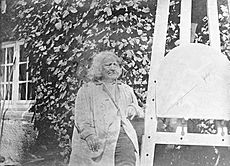

Thorvaldsen was a leading artist of the Neoclassical period in sculpture. His work was often compared to Antonio Canova's. After Canova died in 1822, Thorvaldsen became the most important sculptor in this style. His figures often look more formal than Canova's. Thorvaldsen believed that artists could only become truly great by copying classical art.
He found ideas for his sculptures, like reliefs, statues, and busts, mostly from Greek mythology. He also looked to classic art and books. He made portraits of important people, such as his statue of Pope Pius VII. This statue is in the Clementine Chapel in the Vatican. Thorvaldsen was the only non-Italian artist ever asked to create a piece for this spot. Because he was Protestant, not Catholic, the church did not let him sign his work.
You can see his art in many European countries. The Thorvaldsen Museum in Copenhagen holds many of his works, and his tomb is in its courtyard. Thorvaldsen's Lion Monument (1819) is in Lucerne, Switzerland. This monument remembers over six hundred Swiss Guards who died protecting the Tuileries Palace during the French Revolution. It shows a dying lion lying over broken symbols of the French monarchy.
Thorvaldsen also made powerful statues of historical figures. Two are in Warsaw, Poland: an equestrian statue of Prince Józef Poniatowski and a seated statue of Nicolaus Copernicus. Both are on Warsaw's Krakowskie Przedmieście street. A copy of the Copernicus statue is in Chicago, USA. A statue of Johannes Gutenberg by Thorvaldsen is in Mainz, Germany.
Museums and Collections of Thorvaldsen's Art
The Thorvaldsen Museum in Copenhagen, Denmark, is where Bertel Thorvaldsen's works are shown. The museum is on a small island called Slotsholmen in central Copenhagen, next to Christiansborg Palace. It was designed by Michael Gottlieb Bindesbøll and built with money collected from the public in 1837. The museum displays his marble sculptures and plaster models. These models were used to create the bronze and marble statues you see around the world.
The museum also has Bertel Thorvaldsen's own collection of paintings, Greek and Roman sculptures, drawings, and prints. He collected these during his life. You can also see his personal items that he used for his work and daily life.
Outside Europe, Thorvaldsen is less known. However, his statue of the resurrected Christ, called Thorvaldsen's Christus, is very famous. It was made for Vor Frue Kirke in Copenhagen. In 1896, an American textbook called it "the most perfect statue of Christ in the world."
This statue is very important to members of The Church of Jesus Christ of Latter-day Saints (LDS Church). A large copy of it is at Temple Square in Salt Lake City, Utah. Replicas are also in visitors' centers near LDS Church temples in many cities around the world. These include Mesa, Arizona; Laie, Hawaii; Mexico City; Los Angeles, California; Portland, Oregon; Washington D.C.; Hamilton, New Zealand; and São Paulo, Brazil. The Christus is also a main feature at the visitors' center for the church's Rome Italy Temple. There, it is displayed with Thorvaldsen's statues of the Twelve Apostles.
Other copies of the Christus include a full-size replica at the Johns Hopkins Hospital in Baltimore, Maryland. There is also a bronze copy in Huntsville, Texas. In 2009, a Swedish church even recreated Thorvaldsen's Christus using Lego bricks.
Thorvaldsen was a master at creating sculptures with a sense of movement and flow. You can look at almost any of his sculptures from different angles, and they still look amazing. He was also able to work on very large, monumental pieces. His classical style was very strict. Even so, people at the time saw his art as ideal. A bronze copy of Thorvaldsen's Self-Portrait stands in Central Park, New York.
Gallery: Thorvaldsen's Works
- Bertel Thorvaldsen's sculptures
-
Ganymede Waters Zeus as an Eagle, Thorvaldsen Museum
-
Tomb monument to Pope Pius VII, St. Peter's Basilica, Rome
-
Prince Józef Poniatowski Monument, Warsaw
-
Lion Monument, Lucerne
-
Sir Walter Scott by Bertel Thorvaldsen
-
Possibly Lady Georgiana Bingham, carved c. 1821-1824, National Gallery of Art
See also
 In Spanish: Bertel Thorvaldsen para niños
In Spanish: Bertel Thorvaldsen para niños





